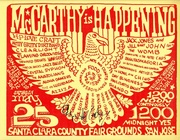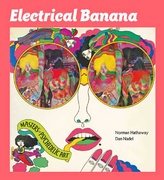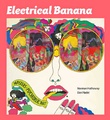
The first time I met Rick Synchef, I was anxious to see his legendary stash of political ephemera and protest posters from the 1960s, which eventually formed the basis of an article for CollectorsWeekly. Synchef had been collecting political paper and ephemera since he was a student in Madison, Wisconsin, which was a hotbed of political activism in the late ’60s. So when I arrived at his home, I was unprepared for the depth and breadth of his other collection of books and periodicals showcasing the work of Beat poets and authors of the 1950s and ’60s, from Charles Bukowski to Gary Snyder.
It wasn’t just the size of Synchef’s cache that was impressive—almost every book on his shelves was signed by its author, and in many cases by the people associated with the title, too. Thus, a copy of Allen Ginsberg’s “Howl” was autographed by the poet as well as his longtime publisher, Lawrence Ferlinghetti of City Lights Bookstore.
The two most impressive books in Synchef’s collection were Jack Kerouac’s “On the Road” (a first-edition paperback from 1958) and Tom Wolfe’s “The Electric Kool-Aid Acid Test” (a first-edition hardcover from 1968). On October 10, 2013, these books, along with several hundred other publications and objects, are up for auction at PBA Galleries in San Francisco. Preview dates are October 8, 9, and 10.

“Tell it John” is an inscription from Neal Cassady to Jack Kerouac, who Cassady used to call John.
Not surprisingly, the Kerouac and Wolfe books are the stars of the sale. Synchef’s “On the Road” may not be the first-edition hardcover, but his copy bears the pencil signature of the elusive Neal Cassady, who was the model for the Dean Moriarty character in Kerouac’s landmark novel. Even more significant to serious collectors are the words below Cassady’s name, “Tell it John,” which means that the signature is actually an inscription to the author, who Cassady and others called John, a diminutive of Kerouac’s given first name, Jean-Louis. Ginsberg’s signature is also there (he was the inspiration for the fictional Carlo Marx), as are the autographs of Cassady’s daughters, Jami and Cathy, who authenticated their dad’s hard-to-find signature for Synchef.
“Wolfe’s book documents a seismic change in the American political and cultural landscape.”
While the Cassady signature gets the award for scarcity, Synchef’s copy of Tom Wolfe’s “The Electric Kool-Aid Acid Test” is like a print version of the famous bus piloted in 1964 by Neal Cassady, Ken Kesey, and his Merry Pranksters, whose exploits Wolfe chronicled in his 1968 tome. Naturally Synchef’s copy features the author’s dandified scrawl, but it also includes 45 other autographs. There’s Kesey, of course, his right-hand Prankster Ken Babbs, and Kesey’s then-girlfriend, Mountain Girl, but Synchef also tracked down writer Wendell Berry, who studied with Kesey in the late 1950s at Stanford University.
Synchef also gathered the signatures of rock-poster artists who were an important part of the early San Francisco scene (Stanley Mouse and Alton Kelley among them), musicians such as Phil Lesh of the Grateful Dead, Sam Andrew of Big Brother and the Holding Company, Barry Melton of Country Joe and the Fish, and Jefferson Airplane drummer Spencer Dryden, as well as a few ’60s impresarios, including “Oracle” publisher Allen Cohen, future “Whole Earth Catalog” mastermind Stewart Brand, and concert promoter Chet Helms of the Family Dog. All these names fill the title and contents pages of Wolfe’s book.

Stand-out signatures on the title page of Wolfe’s book include Ken Kesey and Wendell Berry, who were classmates at Stanford University.
“These are my idols,” says Synchef, when asked what motivated him to fill this particular book with so many signatures. “I looked up to these people because they brought something so new to the country.” Wolfe’s book is significant, Synchef says, because “it documents a seismic change in the American political and cultural landscape. It documents, along with the signatures of those who helped make it possible, a fundamental shift in the American psyche and the emergence of a youthful, politically active culture.”
Because Synchef’s collection is so vast, PBA Galleries is dividing it into three parts, and maybe more. After the auction on October 10, a second auction will be held in January, 2014, focusing on Synchef’s books and other materials about drugs, the Grateful Dead, Timothy Leary, Abbie Hoffman, Jerry Rubin, Paul Krassner, and Ram Dass. A third auction in May, 2014, will be devoted to music, political activism, and artists, from cartoonists to rock-poster artists.
More Beat-Era Gems From the Rick Synchef Collection
(For more information, visit PBA Galleries.)
















 The High Price of a Degree in LSD
The High Price of a Degree in LSD
 Blueprint for the Occupy Movement? Read the Protest Manifestos of the 1960s
Blueprint for the Occupy Movement? Read the Protest Manifestos of the 1960s The High Price of a Degree in LSD
The High Price of a Degree in LSD The Sources of Psychedelic Art? Drugs, But Also Picasso and the Fire-Bombing of Tokyo
The Sources of Psychedelic Art? Drugs, But Also Picasso and the Fire-Bombing of Tokyo BooksThere's a richness to antique books that transcends their status as one of …
BooksThere's a richness to antique books that transcends their status as one of … Mari Tepper: Laying it on the Line
Mari Tepper: Laying it on the Line Nice Ice: Valerie Hammond on the Genteel Charm of Vintage Canadian Costume Jewelry
Nice Ice: Valerie Hammond on the Genteel Charm of Vintage Canadian Costume Jewelry How Jim Heimann Got Crazy for California Architecture
How Jim Heimann Got Crazy for California Architecture Modernist Man: Jock Peters May Be the Most Influential Architect You've Never Heard Of
Modernist Man: Jock Peters May Be the Most Influential Architect You've Never Heard Of Meet Cute: Were Kokeshi Dolls the Models for Hello Kitty, Pokemon, and Be@rbrick?
Meet Cute: Were Kokeshi Dolls the Models for Hello Kitty, Pokemon, and Be@rbrick? When the King of Comedy Posters Set His Surreal Sights on the World of Rock 'n' Roll
When the King of Comedy Posters Set His Surreal Sights on the World of Rock 'n' Roll How One Artist Makes New Art From Old Coloring Books and Found Photos
How One Artist Makes New Art From Old Coloring Books and Found Photos Say Cheese! How Bad Photography Has Changed Our Definition of Good Pictures
Say Cheese! How Bad Photography Has Changed Our Definition of Good Pictures Middle Earthenware: One Family's Quest to Reclaim Its Place in British Pottery History
Middle Earthenware: One Family's Quest to Reclaim Its Place in British Pottery History Fancy Fowl: How an Evil Sea Captain and a Beloved Queen Made the World Crave KFC
Fancy Fowl: How an Evil Sea Captain and a Beloved Queen Made the World Crave KFC
It looks to me like Kesey’s inscription in OFOtCN might read, “…if we dig deeper in the ash” rather than odor. Does anyone know for certain?